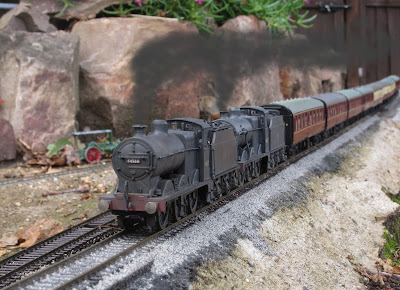(DRAFT)
Overview
General approach: Concrete or brick or building blocks, then a layer of rubbercrete, then roofing felt primer, then 3mm closed-cell foam, then peco flexible track pinned down on curves, then stone ballast held in place with diluted waterproof PVA and enclosing the foam. The straight section up to the tunnel misses out the rubbercrete as pinning was not thought necessary. I have tried other types of ballast and they don’t work and are waiting to be re-done. A of the early ballast, which was not stone, or was fixed with too weak a mix of PVA, came away over the winter. This year, I have been using Pledge "Klear" floor polish instead of the diluted PVA, and it seems so far to have worked.
Not the only way to do it, and probably not the best, but it’s a starting point.
Rubbercrete
I derived the rubbercrete recipe by trial and error:
- 1 part by vol ordinary portland cement
- 0.5 part fine sand
- 2.5 part rubber granules
- 0.2 part SBR
- water to taste
Don’t make too much at once as it goes off in about 5 min. Lay it as accurately as possible; my latest section uses plasticine as shuttering. The tunnel is rubbercrete in cut gutter down-pipe.
Track base and Ballast
I use closed-cell foam as the final track base. It's similar
to the material used for camping sleep-mats, and is sold by Exactoscale. I have used several methods of sticking it down. I
started by using roofing-felt adhesive. It works well but is messy. I then tried
using the roofing-felt adhesive primer only, but this is also messy. (The
problem is that you really need to lay the track while the adhesive is still
wet, to keep the base as level as possible. Inevitably the adhesive gets all
over your hands, particularly if you are forming flexitrack into curves!) For my
most recent length of track, I used builder's waterproof PVA adhesive, but it
hasn't been down long enough yet for me to be able to say whether it's a
success.
Other materials may also work as well, or better. Your best bet is
to try it! I would lay a few test lengths, one using PVA, another using roofing
felt adhesive (if it dosn't melt the material), and leave them outside. A
crucial decision is how you will hold the curves in shape. For long straight
track sections, I glued lengths of the foam, pre-cut to shape, to the concrete base, and glued the track to
the foam, lining it up with a sraight-edge while the glue sets. For the curving
sections I have a layer of rubbercrete under the foam so that I can use track
pins. If you used pre-formed curves or used curve templates to keep the curve
while the glue dries, the rubbercrete could be dispensed with. In all cases, I
have finished with real stone ballast and diluted waterproof PVA. The sections
done this way have lasted a year so far, the sections using synthetic ballast or
ordinary PVA are now bare. If done properly, the finished ballast also helps
keep the track in place.
One feature of a foam underlay is that it can reduce track noise as the train runs over it. However, the addition of a coating of stone ballast and dry PVA reverses this effect with a vengance, and the track noise becomes very obvious. This can of course be a good thing if the track sounds are realistic, and the stretches where I have cut notchs in the rail every 60' sound rather good.
The ballast is real granite bought from peco or other suppliers. I have found that real stone is the only material with any chance of staying in place when the glue is applied, and the only material to survive a winter. There are several schools of thought on the correct size for the ballast. This is partly because different sizes are correct for different types of track and different eras. Look at some photos from the location and era you are modelling. Peco supply "00" and "N" sized ballast. I have even used fine sand for sidings and mineral lines. The ballast is applied with a small spoon and adjusted with a paint-brush, keeping it level with or just below the tops of the sleepers, and providing a realistic shoulder over the edge of the foam. Again, check some photographs of real track to see how it should look. Take care not to apply too much ballast, remembering that it is easier to add one more later than to take some away!










